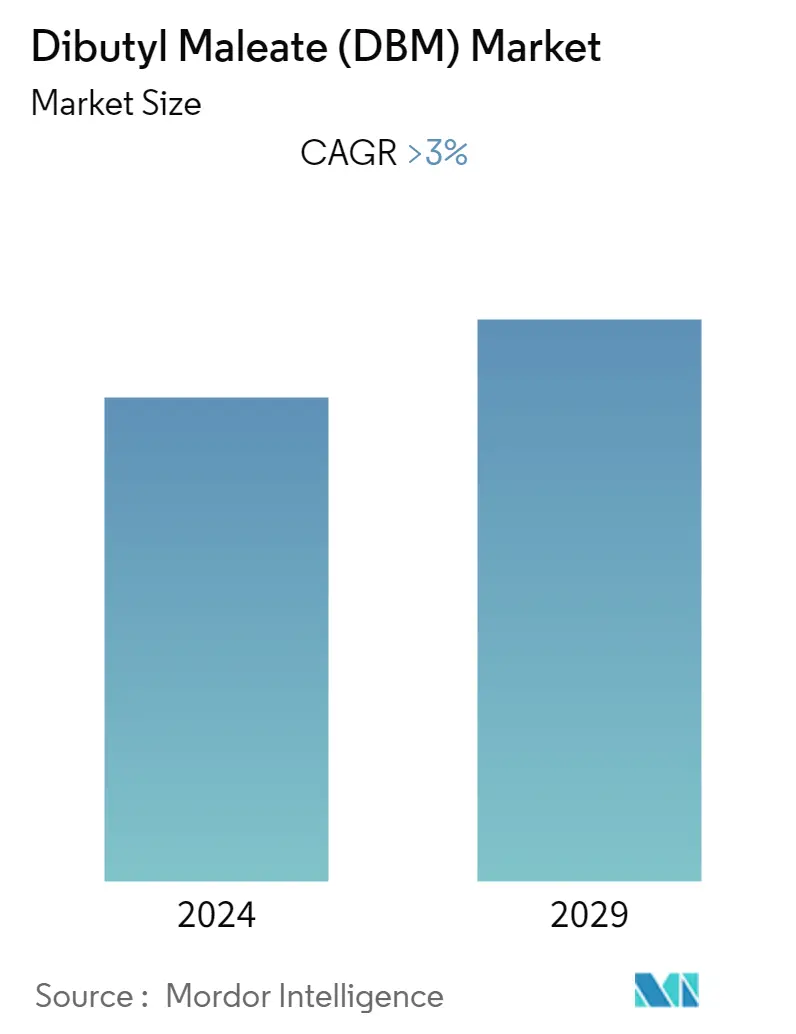Market Size of Dibutyl Maleate (DBM) Industry

| Study Period | 2019 - 2029 |
| Base Year For Estimation | 2023 |
| CAGR | > 3.00 % |
| Fastest Growing Market | Asia Pacific |
| Largest Market | Asia Pacific |
| Market Concentration | High |
Major Players*Disclaimer: Major Players sorted in no particular order |
Dibutyl Maleate (DBM) Market Analysis
The global dibutyl maleate (DBM) market is expected to grow at a CAGR of over 3% during the forecast period. Dibutyl Maleate (DBM) is a colorless liquid with a characteristics "ester" odor. It is used as a comonomer in vinyl and acrylic emulsions polymerizations for paints and adhesives.
- The major factors driving the market studied include growing paints and coatings industry in Asia-Pacific.
- Asia-Pacific region is expected to dominate the global market during the forecast period.
- Inks & Coatings application do dominate the market during the forecast period.
Dibutyl Maleate (DBM) Industry Segmentation
The global Dibutyl Maleate market includes:
| Application | |
| Inks & Coatings | |
| Chemical Intermediate | |
| Plasticizers | |
| Adhesives | |
| Others (Synthetic Lubricants etc.) |
| Geography | |||||||
| |||||||
| |||||||
| |||||||
| Rest of the World |
Dibutyl Maleate (DBM) Market Size Summary
The dibutyl maleate (DBM) market is poised for steady growth, driven by its essential role as a comonomer in vinyl and acrylic emulsions used in paints and adhesives. This colorless liquid, known for its ester-like odor, is crucial in enhancing the flexibility, water stability, and UV resistance of paints, making it a vital component in the coatings industry. The Asia-Pacific region, particularly China, is expected to lead the market due to its burgeoning paints and coatings sector, fueled by increasing construction activities and a robust demand for high-quality coatings. The presence of major global manufacturers and a significant number of local paint companies in China further bolsters the region's dominance in the DBM market.
The demand for dibutyl maleate is anticipated to rise significantly, especially in China, where it is used extensively in coatings, plasticizers, and adhesives. The government's encouragement of foreign investments and the strong production capabilities in the region contribute to this growth. Additionally, countries like India and Japan are also playing a role in the market's expansion. The global DBM market is partially consolidated, with key players such as Celanese Corporation, Sigma-Aldrich, Inc., Polynt, Nayakem, and WeiFang Tuoshi Chemical Co., Ltd. leading the industry. This competitive landscape is expected to shape the market dynamics over the forecast period.
Dibutyl Maleate (DBM) Market Size - Table of Contents
-
1. MARKET DYNAMICS
-
1.1 Drivers
-
1.1.1 Growing Paints and Coatings Industry in Asia-Pacific
-
1.1.2 Other Drivers
-
-
1.2 Restraints
-
1.3 Industry Value-Chain Analysis
-
1.4 Porter's Five Forces Analysis
-
1.4.1 Bargaining Power of Suppliers
-
1.4.2 Bargaining Power of Consumers
-
1.4.3 Threat of New Entrants
-
1.4.4 Threat of Substitute Products and Services
-
1.4.5 Degree of Competition
-
-
-
2. MARKET SEGMENTATION
-
2.1 Application
-
2.1.1 Inks & Coatings
-
2.1.2 Chemical Intermediate
-
2.1.3 Plasticizers
-
2.1.4 Adhesives
-
2.1.5 Others (Synthetic Lubricants etc.)
-
-
2.2 Geography
-
2.2.1 Asia-Pacific
-
2.2.1.1 China
-
2.2.1.2 India
-
2.2.1.3 Japan
-
2.2.1.4 South Korea
-
2.2.1.5 Rest of Asia-Pacific
-
-
2.2.2 North America
-
2.2.2.1 United States
-
2.2.2.2 Canada
-
2.2.2.3 Mexico
-
-
2.2.3 Europe
-
2.2.3.1 Germany
-
2.2.3.2 United Kingdom
-
2.2.3.3 Italy
-
2.2.3.4 France
-
2.2.3.5 Rest of Europe
-
-
2.2.4 Rest of the World
-
-
Dibutyl Maleate (DBM) Market Size FAQs
What is the current Dibutyl Maleate (DBM) Market size?
The Dibutyl Maleate (DBM) Market is projected to register a CAGR of greater than 3% during the forecast period (2024-2029)
Who are the key players in Dibutyl Maleate (DBM) Market?
Celanese Corporation, Sigma-Aldrich, Inc., Nayakem, WeiFang Tuoshi Chemical Co., Ltd and Polynt are the major companies operating in the Dibutyl Maleate (DBM) Market.

